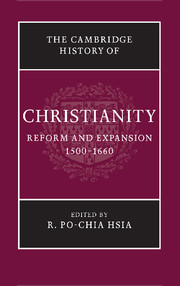Book contents
- Frontmatter
- Part I Luther and the Holy Roman Empire
- Part II The Second Reformation
- Part III Catholic Renewal
- Part IV Resolving Confessional Conflicts
- Part V Religion, Society, and Culture
- 19 The Reformation and the visual arts
- 20 Ritual in early modern Christianity
- 21 Music and religious change
- 22 Demonology, 1500–1660
- 23 Science and religion
- 24 The new clergies
- 25 Women and religious change
- Part VI Christianity and Other Faiths
- Bibliography
- Index
- References
20 - Ritual in early modern Christianity
from Part V - Religion, Society, and Culture
Published online by Cambridge University Press: 28 March 2008
- Frontmatter
- Part I Luther and the Holy Roman Empire
- Part II The Second Reformation
- Part III Catholic Renewal
- Part IV Resolving Confessional Conflicts
- Part V Religion, Society, and Culture
- 19 The Reformation and the visual arts
- 20 Ritual in early modern Christianity
- 21 Music and religious change
- 22 Demonology, 1500–1660
- 23 Science and religion
- 24 The new clergies
- 25 Women and religious change
- Part VI Christianity and Other Faiths
- Bibliography
- Index
- References
Summary
All the observances of the temple have to be learned by the person, for the visible ceremonies or practices announce the invisible.
Throughout the history of Christianity, leaders of the faith have found in ecclesiastical ritual an indispensable means of inculcating correct doctrine upon the unlettered and theologically uninitiated masses. As the religion of small communities and face-to-face acquaintance gave way in the western Roman Empire to territorial conversion, increasingly bishops sought to unite those in their care within a framework of observances that reinforced pastoral teachings. Indeed, through long ages of clerical under-instruction for their duties, mastery of the rites of the church constituted the core of professional preparation for the priesthood. For nearly two millennia, Christian authorities have assigned paramount importance to the proper understanding and execution of central observances, such as baptism and the eucharist.
As attractive and useful as the invocation of a ritual’s antiquity is, however, scholars in many disciplines have noticed the marked changes introduced as a result of theological controversy, as well as of changed historical circumstances. The recitation of creeds, those summaries of belief, followed the bishops’ taking of positions that formally set them apart from their challengers. Peter Cramer has traced the evolution of baptism in the West during nearly a thousand years. Medievalists are aware that the Fourth Lateran Council of 1215 elevated marriage to sacramental status, requiring the consent of both bride and groom. This same council played a significant part in compelling all Catholics to confess to their priests and receive Holy Communion a minimum of once a year.
- Type
- Chapter
- Information
- The Cambridge History of Christianity , pp. 371 - 385Publisher: Cambridge University PressPrint publication year: 2007



